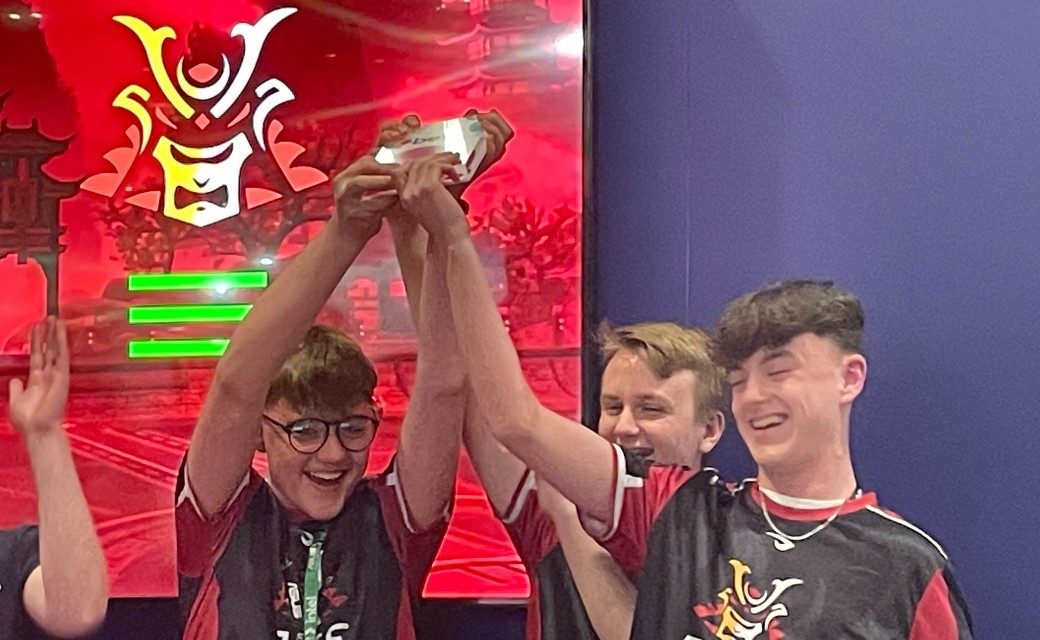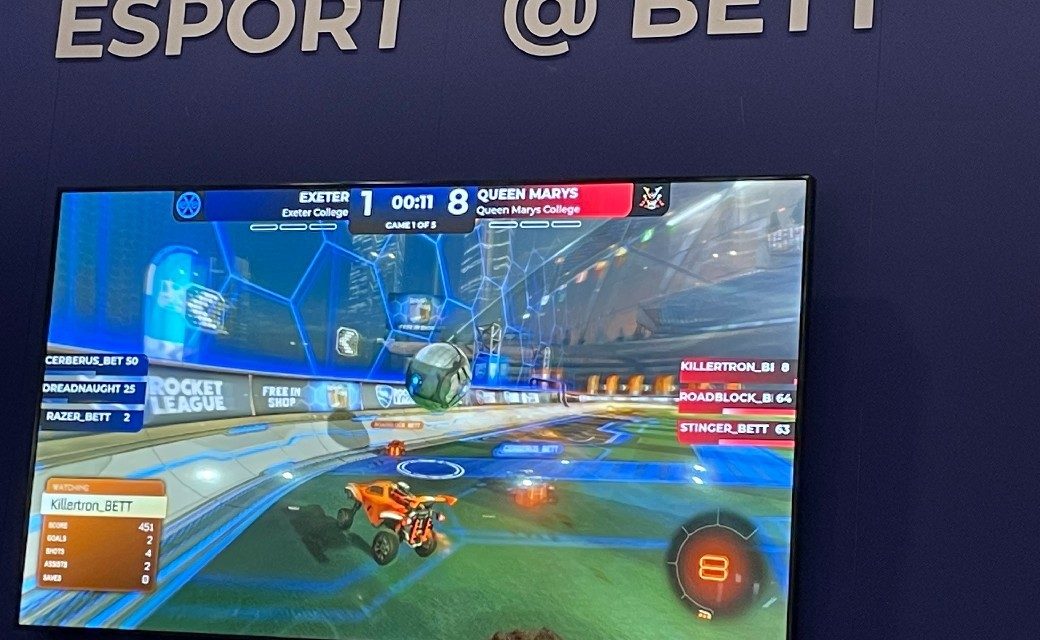
My previous blog post went slightly off topic in terms of the physical delivery of the BTEC and peaked beyond the boundaries of a specification in order to highlight the opportunities available to schools and colleges outside of the classroom. As it turned out, the responses and reaction to that took me pleasantly by surprise as it clearly helped educators to start to think about the bigger picture and the potential of the esports offer to any curriculum. But this article sees a return to the teaching and the beast that is Unit 2!
 Sitting at 120 credits the mandatory Esports Skills, Strategies and Analysis is most definitely a unit that needs some thinking about! At the BETT 2022 show in March this year I had the privilege of being given the opportunity by Pearson to speak on the esports stage about the delivery of the BTEC and what I said about ‘busting some myths about the BTEC’ grabbed the interest of the Pearson BTEC team who quoted it on Twitter and LinkedIn.
Sitting at 120 credits the mandatory Esports Skills, Strategies and Analysis is most definitely a unit that needs some thinking about! At the BETT 2022 show in March this year I had the privilege of being given the opportunity by Pearson to speak on the esports stage about the delivery of the BTEC and what I said about ‘busting some myths about the BTEC’ grabbed the interest of the Pearson BTEC team who quoted it on Twitter and LinkedIn.
Now I fully support that statement (obviously) and would be happy to argue with anyone who says different but if there’s potentially one unit that could catch people out I would suggest it’s Unit 2, hence the term ‘the beast’!
Why do I call Unit 2 The Beast?
When you read through the learning aims of Unit 2, at various points there are areas that need to be covered that are very specific to esports and perhaps more importantly, specific to games across different genres. Before I go on, I would like to make it clear that I’m not here to scare anyone or put anyone off as even with no prior knowledge, I know all of you who are professional educators are more than capable of learning what needs to be taught. So, let’s go into some of those specifics.
How many of you could discuss ‘macro and micro’ skills within multiple games played in esports? Could you discuss knowledge of in-game roles and skills such as characters, abilities and strategies across numerous games from different genres? When it comes to strategies, how would you define ‘Blitz’, ‘Funnel’, ‘Split Push’, ‘Rush’, ‘Rotations’? These are all terms listed in the specification but if you’re already starting to panic – don’t!
If we go back to one of my first articles I raise a key point about resources, and I touch upon it again in subsequent articles, and that is that one of your greatest resources is… your students!
Your students are often the best resource you have
When delivering Unit 2, the first task I set my 70 or so students before I began teaching was to create a glossary explaining some of the key terms identified in the unit. It sounds so simple and obvious when it’s written down, but this provides you with an invaluable (and usually accurate) source of information which you can then quote back to them later in your delivery, but in doing this they have offered you a huge resource bank that you can dip into at any time.
The majority of what needs to be taught across learning aims A & B in Unit 2 is relatively straight forward. We all understand the characteristics of what makes a high performing team in any sport; professionalism, positive attitude, team dynamics, etc., and therefore we can simply apply the same logic to esports teams. You can also have some fun with many aspects of these areas. When teaching communication within esports, my colleague Natasha and I found ourselves with a spare five minutes on a Friday afternoon so we came up with this!
Everyone enjoyed the tasks (especially us observing) and all of the students started to think about planning, strategy, problem solving in a bid to get the highest scores, which served as an engaging way to get the students thinking on the right lines about the importance of communication.
But going back to a potential banana skin; when it comes to teaching students about skills and strategies in games played within esports, there are two key things I would like to highlight.
Evaluating skills and strategies across different genres
Firstly, in order to achieve the highest grades, students must evaluate skills and strategies across different genres, so herein lies the first problem. Your students may be different to mine, but after conducting an initial survey at the start of the academic year, it became very clear that you’ll have no problem with Battle Royal (BR), First Person Shooters (FPS), and to a large extent, sports games like Rocket League.
The same cannot be said about MOBAs (multiplayer online battle arenas) and RTS (real time strategy) games, these genres are not played by the majority of my students, in fact out of 70 students only two play MOBA and three play RTS.
But why does that matter? In terms of their learning it doesn’t, surely that’s the point of education – to learn new things, but what is worth thinking about is how it influences your teaching. When delivering material for key skills and strategies across genres I spent considerably more time discussing MOBAs and RTSs in the knowledge that my students will need this information to successfully undertake their assignment.
I also made this clear to them and explained that I would be teaching much less around BR and FPS as they already knew it and probably knew more than I (there’s no point pretending, as they’ll catch you out!).
My role was to supply the basics for the popular genres and the details for the less so – adapt your own teaching and play to their strengths.
The structure of assignments
The second element I would like to discuss involves the structure of assignments within Unit 2. I chose to include learning aim A and B in the first assignment which required two separate tasks.
Across three different groups the same thing happened (which I later discovered had happened the previous year when delivered by a colleague): the students excelled at Task 1 (learning aim A) and really struggled with Task 2 (learning aim B).
Task 1 involves the students talking about skills, tactics and training required in different genres of games. The students clearly enjoyed writing about the games they play, the games they love! Some of the work was so detailed it would easily have passed at level 4 and some level 5, I have never awarded so many distinctions for a learning aim.
However, that came at the cost of Task 2 where they had to discuss characteristics of and best practice in high performing teams. So much time had been spent writing about what they enjoyed there was a distinct lack of effort in too many cases for the second task!
Oh… Did I forget to mention B3. The creation of an esports team?
Yes, I did, and so did the majority of the students!
Despite being clearly identified within the brief even the strong students who wrote B1 and B2 beautifully failed to discuss B3 and had to resubmit in order to complete the assignment. When such an obvious pattern emerges and you notice it, you really can’t afford to ignore it. Next year I will be setting two separate assignments for learning aims A & B and breaking it down into smaller parts so they can focus on each separately and I haven’t even touched on learning aims C & D yet.
But ‘the beast’ that is Unit 2 is a 120 credit mandatory unit, so it’s ok to break it down and perhaps change the more traditional methods of splitting assessments. It’s also ok to admit you may have got things wrong! I am holding my hands up now to not considering the assessment pattern enough – but until you’ve tried you can’t always be sure. One thing I can be sure of is things will be changed for next year!
If you would like to talk about the delivery of the BTEC or have questions please don’t be afraid to get in touch I’m more than happy to help and if you’re interested in using the resources I have produced please head over to my TES Shop.
Learn more about BTEC International Level 3 Esports
Sign up to receive our blog updates
Like what you read and want to receive more articles like this direct to your inbox? Subscribe to our blog and we’ll send you a fortnightly digest of the blog posts you may have missed, plus links to free resources to support your teaching and learning.
